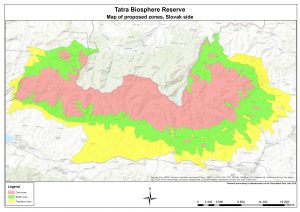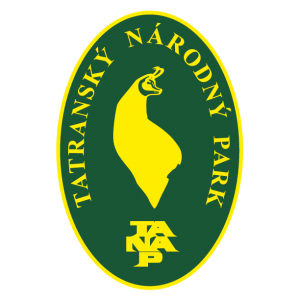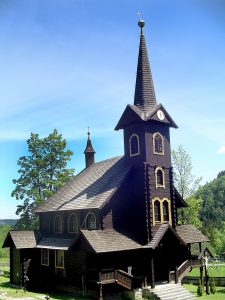Tatry Biosphere Reserve
web: tanap.sopsr.sk
Year of designation: 1992 – bilateral, Polish-Slovak “Tatra Biosphere Reserve”
Total area: 101 819,05 ha
The Tatry Biosphere Reserve (hereafter BR) are situated in the Northern part of the Slovak Republic. The territory of the transboundary Tatry BR covers two national parks on either side of the political boundary between Poland and Slovakia. The Slovak is made up of the Tatry National Park – Tatranský národný park (TANAP) and the Polish side is made up of the current Tatry National Park –Tatrzański Park Narodowy (TPN). The Tatry BR was approved by UNESCO’s Programme on Man and the Biosphere in 1993.
The selfhood and quaintness of the natural conditions of the Tatry BR lies above all in their high mountain character. This is reflected in the distinctive landscape differentiation, which depends mainly on the orographic layout, massiveness, extent and height of the mountain range. The complex geological development, the extremely rugged surface, and the changing climatic conditions made it possible to preserve the immediately following postglacial processes and condition in the Tatra Mountains on the largest surface today.
The Tatry BR encompasses the three mountain ranges of the region, the High Tatras, the Western Tatras and the Belianske Tatras. It has a special position within a Carpathians Arch due to its outstanding attributes including:
- Unique high mountain relief with distinct features of former glacial activity

- Numerous glacial lakes (tarns)

- Numerous endemic plant and animal species (Carpathian endemics)
- Largest alpine zone in Slovakia
- Outstanding alpine (Larix decidua, Pinus cembra forests)
- Well preserved natural forests in spruce forest zone.
.
The manifold color of the territory is enhanced by preserved features of traditional folk culture. The folk culture and folklore of this region have many things in common, but they also differ significantly from neighbouring regions in Poland and Slovakia. These differences are manifested in folk costumes, folk clothing, music, dancing and singing.
Development function
Traditional use of Tatry BR is agriculture and forestry. Since the beginning of historical develoment, agriculture was connected with cattle and sheep breeding. The tourism started to appear since 1871. Unfortunetly development funciton was realised not in Transition Area of Tatry BR, but inside of TANAP territory. The plan of territorial development in the High Tatry Mts. from 1959 included a reverse order of the TANAP’s priorities: recreation, tourism and sports, hath care and research.
Conservation function
The Tatry National Park was first protected area in Slovakia with official zonation. In ecological terms, the Tatry BR are one of the characteristic regions of the Carpathian arc, with wast mountain forests and unique alpine landscape. Six major altitudinal vegetation zones can be recognized.
The mountain landscape with resort and tourist settlements is a trantransition between the cultivated and natural parts of the region, including many types of forest, with greate biotic diversityThe Tatry BR are rich in reptile, amphibian, birds and mammal species. Alpine hydrofauna which lives in glacial lakes include Trichodrilus tatranesis, known only from the Tatry Mts., and glacial relic Branchynecta paludosa. There are many rarre crustaceans, cyclops, water fleas and water lice. Carnivores include brown bear (Ursus arctos), lynx (Lynx lynx), wolf (Canis lupus), common wild cat (Felis silvestris), pine marten (Martes martes) common badger (Meles meles), and other more common species.
Logistic function
Multidisciplinary and detailed research in Tatry BR started after the foundation of the Research Station in 1953 in Tatranská Lomnica. This is one of the few scientific field stations in Slovakian mountains, and provides a base for research throughout the Tatras. The principal task of the scientists of the TANAP Research Station and their collaborators is environmental impacts deriving both from the high number of visitor and from air and wate pollution. Since 2000 in Tatranská Javorina started the high – mountains biological research effected by Research Institute of HIgh MOuntain Biolgoy of the University in Žilina. Enviromental education in Tatry BR includes development of activity in the area of special educational facilities, as well as publication and promotional activities.



